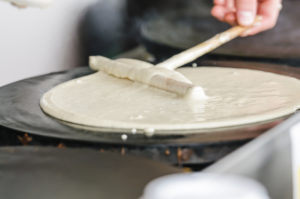Ooh, tender, delicate, delicious crepes… Just the idea of eating these enticing morsels is enough to start your mouth watering! There are crepe options suitable for every meal but breakfast crepes are obviously the best.
We all know how delicious crepes are, but where did they come from originally?
The origin of crepes
The history of crepes dates back to 13th century Brittany, France. It seems a housewife there accidentally dribbled some thin porridge onto a hot, flat cooktop. Since people back then weren’t inclined to waste even their smallest cooking mistakes, she ate it. The rest, as they say, is history. Of course, this might just be the French equivalent of an urban legend but it does make for a pretty good story.
 Another interesting history of crepes concerns hearty, earthy buckwheat crepes. Like the other story, thin buckwheat porridge spilled and became a thin, crispy crepe instead. What a delightful change in texture that must have been!
Another interesting history of crepes concerns hearty, earthy buckwheat crepes. Like the other story, thin buckwheat porridge spilled and became a thin, crispy crepe instead. What a delightful change in texture that must have been!
Traditionally, buckwheat crepes are served with savory fillings while the more delicately flavored wheat crepes are served with fruit and other sweet fillings. Want another interesting historical fact about crepes? Whenever milk was in short supply during the Middle Ages, intrepid crepe lovers used a mixture of wine and water as a substitute!
A crepe by any other name
These delicate pancakes are known as ‘crêpes’ in France. Their name comes from Old French ‘crespe’ which traces back to the Latin ‘crispa’ or ‘crispus’ which means curled. This probably refers to their often slightly ruffled edges. A French café that specializes in crepes is known as a crêperie. In Brittany, they still prefer crepes made with local buckwheat flour and use the slightly derisive ‘crêpes de froment’ to refer to crepes made with white flour.
The day of the crepe
In France, that day translates to ‘le jour des crêpes’ and it occurs every February 2nd. Historically, this day was known as the Virgin Mary’s Blessing Day or La Chandeleur (‘the return of the light’) and celebrated the coming return of spring. Now, it’s best known as the day when everyone eats crepes!
In case you want to emulate the French, make sure you fold your crepes rather than rolling them like we do in America. Folding your crepes keeps the toppings inside where they belong. That’s important since there are as many street corner crepe vendors in France as there are hot dog vendors in America!
Sweet, savory, or plain?
Lemon and sugar were the traditional simple filling used in sweet crepes. Now, you’ll find them with an amazing array of fillings. Nut spreads, jams and preserves, berries, nuts, cream cheese, whipped cream, ice cream, salted caramel, and poached pears drizzled with dark chocolate are all popular fillings. At Original Pancake House in Denver, we particularly like cherry Kijafa, fresh strawberries or sliced bananas with a warm pecan praline sauce. Yum!
 The traditional ham, egg, and cheese filling in savory crepes is still popular. However, now you’ll also find asparagus, avocado, spinach, mushrooms, bacon, chicken, smoked salmon, steak, turkey, Swiss cheese, goat’s cheese, and a variety of other vegetables, meats, and cheeses filling crepes.
The traditional ham, egg, and cheese filling in savory crepes is still popular. However, now you’ll also find asparagus, avocado, spinach, mushrooms, bacon, chicken, smoked salmon, steak, turkey, Swiss cheese, goat’s cheese, and a variety of other vegetables, meats, and cheeses filling crepes.
Of course, a plate of paper-thin and elegantly simple plain crepes are also delicious in all of their not-so-humble glory. They are still crepes, after all! That’s why we offer them for our customers who enjoy the simple goodness of perfectly prepared crepes.
The next time you’re in the mood for breakfast crepes, head on over to The Original Pancake House. Use the Yelp waitlist to save your place in line so you can dig into our delicious crepes as soon as possible. Bon Appétit!
